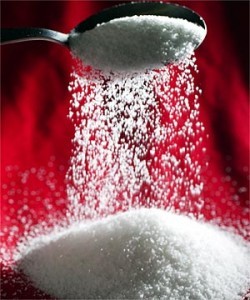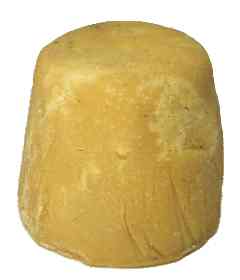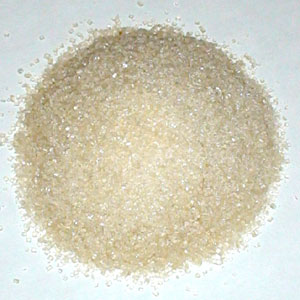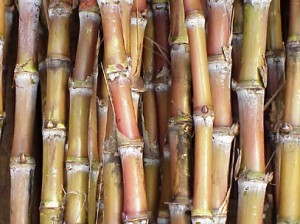 By Dr. Rita Khanna
By Dr. Rita Khanna
White sugar consists of only one kind of molecule – sucrose, which is also called “table sugar” or “saccharose.” Sucrose is a white crystalline disaccharide – yet it is far from pure in the sense of being a natural product. Sucrose is the most popular of the various sugars for flavoring, as well as properties (such as mouth feel, preservation, and texture) of beverages and food.
History of Sugar
Sugar originated from India. When Alexander the Great invaded India in 325 BC, he found a crude, dark brown substance called jaggery, (gur), which is still used today. Jaggery spread to Japan and China; then to the Middle East. From there, European crusaders took it to the Canary Islands, and it was from here that Christopher Columbus took sugarcane to Europe. Europeans processed all the goodness out of natural sugar, leaving only the super-sweet, artificially white crystals, which have since become popular throughout the world. Currently, Brazil has the highest per capita production of sugar.
Sugar Addiction
Whenever we consume any substance, the body must make internal adjustments, in order to break it down into its usable components, and to eliminate toxic elements. Certain enzymes are manufactured, hormone secretions are altered, and there are changes in organs – such as: the liver and in the composition of the blood. Every time a substance is taken, the same cycle of internal chemical reactions takes place, and continued use reinforces this cycle. With addictive drugs, like alcohol or even caffeine, this pathway becomes fixed.
There are permanent changes in body chemistry, such that we must take this drug in order to maintain normal bodily activity. If we stop, then the body sends a sharp protest to the brain; and we experience intense desire or craving for that drug. We may experience pain and illness, as the drug pathway breaks down, and a new internal balance is established. This is not only true of heroin, but also of refined, white sugar. Although we do not think of it as such, white sugar is a drug; and most people are sugar addicts. There is not only sugar in your tea or in sweets, but also in jams, fizzy drinks, cakes, pastries, baby foods, and most canned products – from puddings, to meat, and vegetables. Try to cut out sugar from your life and see how soon the craving begins.
Sugar Refining
 Sugar is extracted from sugar beet or, more often, from sugarcane. Sugarcane is a variety of grass that thrives in tropical climates and can grow as high as twenty feet. After harvesting, the cane is shredded and crushed to extract the juice. This is clarified with lime, to remove impurities, and the residue is boiled – until a mixture of crystals and syrup is formed.
Sugar is extracted from sugar beet or, more often, from sugarcane. Sugarcane is a variety of grass that thrives in tropical climates and can grow as high as twenty feet. After harvesting, the cane is shredded and crushed to extract the juice. This is clarified with lime, to remove impurities, and the residue is boiled – until a mixture of crystals and syrup is formed.
These are separated into:
• Syrup or molasses, which is further refined into treacle and golden syrup.
• Crystals of ‘raw sugar’. This is the brown sugar preferred by naturalists and health food advocates.
This ‘raw sugar’ is already ninety-six percent sucrose. The other four percent is only water, inverted sucrose, dirt, and sugar lice. This raw sugar is then cleaned and polished, giving white crystals that are completely devoid of health-giving nutrients.
White Sugar vs. Carbohydrates
 • Carbohydrates are our source of energy and are an essential part of our diet. White sugar is also a carbohydrate, but is not our only source of energy. Honey, fruit, vegetables; and all grains, especially rice, contain natural sugar – together with many other vital elements essential for health. The tragedy is that we eat more sugar, which has taste and energy-value but nothing else, and less of these other carbohydrate foods, and so deprive ourselves of important nutrients. Then, we suffer from malnutrition, as a result of addiction to sugar.
• Carbohydrates are our source of energy and are an essential part of our diet. White sugar is also a carbohydrate, but is not our only source of energy. Honey, fruit, vegetables; and all grains, especially rice, contain natural sugar – together with many other vital elements essential for health. The tragedy is that we eat more sugar, which has taste and energy-value but nothing else, and less of these other carbohydrate foods, and so deprive ourselves of important nutrients. Then, we suffer from malnutrition, as a result of addiction to sugar.
• The level of sugar in our blood must be kept constant. This requires expenditure of energy and work by the body. When we eat natural carbohydrates, these substances are gradually, and slowly, broken down by the processes of digestion, and then enter the blood stream. The level does not rise excessively and can be easily handled by the body.
• If we bombard our system with excess sugar, we quickly raise our blood glucose level. This places a demand and stress on the body. The pancreas must release more insulin, and at just the right time. A healthy body copes with this situation, with no trouble at all. However, constant use of large amounts of refined sugar, eventually, causes the body to become unbalanced and diseased.
Effects of Excess Sugar
The effects are lethargy, tiredness, inability to concentrate, adrenal gland dysfunction, and diabetes. Lethargy results from imbalance in the endocrinal glands, which affect the Chakras and the Pranic level in our bodies. Strain on the pancreas and adrenal glands is registered by the gland controlling nervous and endocrine systems. One master endocrine gland, the pituitary, adjusts the other endocrine glands accordingly; and thus, the whole system is affected by this stress.
Inefficient breathing is also a cause of lethargy, because oxygen is needed to burn up glucose for energy. If there is not enough oxygen, the glucose energy cycle will produce large amounts of waste acids, such as lactic acid and pyruvic acid. These acids create muscle and joint pains and stiffness. We tire and feel fatigue more easily. Anything, in excess, is detrimental to the health of body and mind; so is the case with refined sugar. Today, research is proving the link between sugar and illnesses, such as headache, skin disease, acidity, tooth decay, obesity, and diabetes. Sugar consumption has also been implicated in such deadly diseases as coronary heart disease, circulatory disorders, and cancer.
How Much Refined Sugar Can One Safely Eat?
 Each individual must use his awareness and discretion in deciding how much sugar can be taken, and this awareness is refined through Yogic techniques. The amount of sugar consumed by each person will vary from day-to-day, and according to individual need. Some people eat no sugar at all. To decide what a healthy amount of sugar is, we must first understand the following points:
Each individual must use his awareness and discretion in deciding how much sugar can be taken, and this awareness is refined through Yogic techniques. The amount of sugar consumed by each person will vary from day-to-day, and according to individual need. Some people eat no sugar at all. To decide what a healthy amount of sugar is, we must first understand the following points:
• Excess sugar is not healthy.
• We do not need to eat refined sugar. We can get carbohydrates from natural produce, such as honey, fruits, and grains.
• It may not be healthy to completely remove all sugar from our diet. Many of us have experienced cravings for sugar, in one form or another, and suppression of these urges can create neurosis.
• The point to keep in mind is that it is not the occasional indulgence that kills us, but the daily bad habits, which insidiously build up and poison our system.
Thus, we suggest that you become aware of just how much sugar you use daily; the number of spoons of sugar in each cup of tea, how many sweets, how much cake, how much sugar, in its hidden forms. Add up the amount and ask yourself whether you are indulging yourself or not. Some people do not care about their health, until it is too late. Then, when they contract diabetes, or some other disease, they repent and seek help. Prevention is better than cure.
How Can Yoga Help Us?
 Yoga is the ideal system to help in this situation. Asanas help balance the endocrine glands, and massage the internal organs – removing waste acids and other impurities. Pranayama gives the body extra oxygen, to burn up excess glucose, plus impurities. Techniques, such as the Shatkarmas help to remove diabetes, by cleaning the whole digestive tract, by resting the glands and associated structures, and by infusing Prana.
Yoga is the ideal system to help in this situation. Asanas help balance the endocrine glands, and massage the internal organs – removing waste acids and other impurities. Pranayama gives the body extra oxygen, to burn up excess glucose, plus impurities. Techniques, such as the Shatkarmas help to remove diabetes, by cleaning the whole digestive tract, by resting the glands and associated structures, and by infusing Prana.
In Yoga, you do not have to give up your indulgences; just become aware of them, their effect on you and your needs, cravings and desires. Regular practice of Yoga will increase your awareness and discriminative faculties, to the point where your life balances out to a natural, harmonious, and healthy level. Sugar consumption will then be regulated naturally, according to your need. At the same time, some of the bad effects will be eliminated, while the good effects are enjoyed. Yoga is, therefore, an excellent way to overcome the bad effects of sugar.
Aum Shanti
If you feel inspired by this article, feel free to publish it in your Newsletter or on your Website. Our humble request is to please include the Resource as follows: –
Courtesy: Dr. Rita Khanna’s Yogashaastra Studio.
A popular studio that helps you find natural solutions for complete health.
Mobile: + 919849772485
Ph:-91-40-65173344
Website: www.yogashaastra.in
Dr. Rita Khanna
Dr. Rita Khanna is a well-known name in the field of Yoga and Naturopathy. She was initiated into this discipline over 25 years ago by world famous Swami Adyatmananda of Sivananda Ashram in Rishikesh (India).
Dr. Rita Khanna believes firmly that Yoga is a scientific process, which helps us to lead a healthy and disease-free life. She is also actively involved in practicing alternative medicines like Naturopathy. Over the years, she has been successfully practicing these therapies and providing succour to several chronic and terminally ill patients through Yoga, Diet and Naturopathy. She is also imparting Yoga Teachers Training.
At present, Dr. Rita Khanna is running a Yoga Studio in Secunderabad (Hyderabad, India).
More Articles By Dr. Rita Khanna:
Control Depression Through Yamas and Niyamas
Pranayama and the Mechanism of Respiration
Please visit the following link to see our online Yoga teacher training courses.
https://aurawellnesscenter.com/store/
Are you interested in Meditation Teacher Training?
Click here to see our online Yoga Nidra teacher training course.
Are you an experienced teacher looking for YACEP credits or continuing education?
Subscribe to Our Newsletter for Special Discounts and New Products
Related Resources
52 Essential Principles of Yoga Philosophy to Deepen your Practice
by Rina Jakubowicz
A Relaxing Way to De-stress, Re-energize, and Find Balance
by: Gail Boorstein Grossman
YOGA: THE PATH TO HOLISTIC HEALTH
by B.K.S. Iyengar
TEACHING YOGA: Essential Foundations and Techniques
By Mark Stephens

Can you give me more information on Jaggery (gur) please.
Dear Dr Khanna,
Many thanks for this informative article on Sugar and role of Yoga in keeping level of sugar in the body. Please also let us know the advantages of jaggery (Gur) over the white sugar.
nice article
The level of sugar in our blood must be kept constant and when it has balance then it nectar nor it poison.
Sometimes sugar bring bad effect for human body but Yoga is an excellent way to overcome the bad effects of sugar.